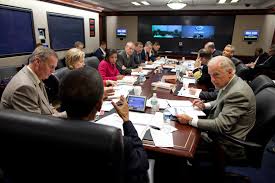SELECTION
According to the Constitution, the President serves a four-year term of office. The 22nd Amendment further requires that a President may not be elected more than twice, nor serve more than a total of ten years. The Constitution also created an electoral college to select the President.Some of the founders wanted to select a President by popular vote, but others did not want to put that much power into the hands of the voters. Others believed that Congress should select the President, but then, what would happen to separation of powers and checks and balances? So they compromised and created a special body of electors to be selected by the states. The number of electors would be equal to the sum of a state's Senators and Representatives, so that large states would have more electors than the small ones.
Today many people believe that the Electoral College is out of date and that Presidents should be chosen by direct election, just as members of Congress are selected. Currently, state electors vote for the candidate that the people selected in the general election during state conventions; but, they are not necessarily bound to do so.
The Electoral College also adds one nettlesome wrinkle - it is possible for a President to win more of the popular vote and lose the election. For example, if the Democratic candidate gets even one more vote than a Republican in a state, all the state's electoral votes go to the Democrat. Therefore, if a candidate wins small states by large numbers and loses large states by narrow margins, it is possible to gain more votes than an opponent and win fewer electoral votes. Five presidents - John Quincy Adams, Rutherford B. Hayes, Benjamin Harrison, George W. Bush, and Donald Trump - have been elected in this fashion.
SUCCESSION
The Constitution originally said little about presidential succession. It only specified that powers and duties should "devolve on the Vice President." Numerous succession situations over the years have shaped the current policy, defined in the 25th Amendment, adopted in 1967.What happens when the presidency is vacated before an election? The Vice President becomes President, and then selects a Vice President that must be confirmed by both houses of Congress. What if something should happen to the President and Vice President at the same time? Then the Speaker of the House takes the presidency, and the President pro tempore of the Senate becomes Vice President. The line of succession then goes to the Cabinet members, in the order of their creation. Thus, the line of succession is as follows:
- President of the United States
- Vice-President of the United States
- Speaker of the House of Representatives
- President of the Senate Pro Tempore (becomes VP when Speaker becomes President)
- Secretary of State
- Secretary of the Treasury
- Secretary of Defense
- Attorney General
- Remaining Cabinet Secretaries...
THE VICE PRESIDENT
What does the Vice President do? The only given constitutional duty is to preside over the Senate, a job with virtually no power since the Vice President can only vote in the event of a tie. Indeed, the nation's first Vice President, John Adams, called the post "the most insignificant office that ever the invention of man contrived."The President, then, has almost total control over what the Vice President does. If he chooses to give him many responsibilities, the Vice President can have a significant amount of power. But the President must be willing to delegate the Vice President that power.
In recent years Presidents have given their Vice Presidents more and more to do. They have headed commissions and organized major projects. The Vice President often makes goodwill missions and attends ceremonies and celebrations. If the President regularly asks for advice, then the Vice President has some real, though indirect, power.
This dependency on the President has made it very difficult for a Vice President to successfully run for President. Only twice in American history has a seated Vice President been elected to the presidency. In 1837, Vice President Martin Van Buren succeeded Andrew Jackson, and in 1989, Vice President George H. W. Bush succeeded Ronald Reagan; neither won reelection.





